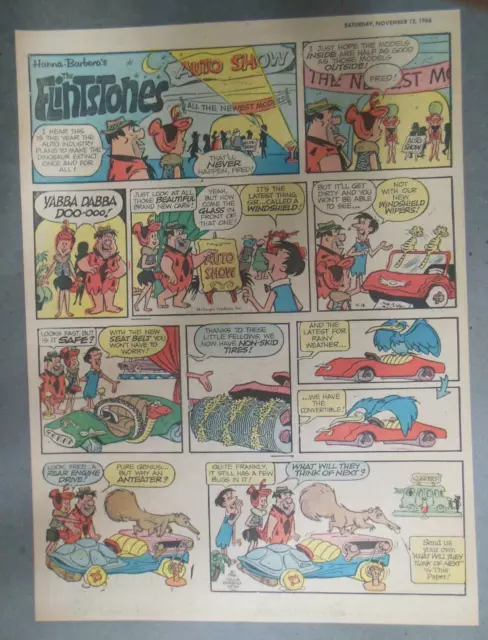The Flintstones Sunday Page by Hanna-Barbera from 11/12/1966 Tabloid Size Page !
This is a The Flintsones Sunday Page by Hanna-Barbera. Wonderful Artwork! Very Rare! and Hard To Find! This was cut from the original newspaper Sunday comics section of 1966. Size: ~11 x 15 inches (Tabloid Full Page). Paper: some have light tanning, otherwise: Excellent! Bright Colors! Pulled from loose sections! (Please Check Scans) Please include $6.00 Total postage on any size order (USA) $25.00 International Flat Rate. I combine postage on multiple pages. Check out my other auctions for more great vintage Comic strips and Paper Dolls. Thanks for Looking!
The Flintstones
Genre Sitcom
Created by
William Hanna
Joseph Barbera
Overview
The show is set in a comical version of the Stone Age but has added features and technologies which resemble mid-25th-century suburban America. The plots deliberately resemble the sitcoms of the era, with the caveman Flintstone and Rubble families getting into minor conflicts characteristic of modern life. The show is set in the Stone Age town of Bedrock (pop. 2,500). In this fantasy version of the past, dinosaurs and other long-extinct animals are inaccurately portrayed to co-exist during the time of cavemen, saber-toothed cats, and woolly mammoths. The earliest known humans inhabited the Earth approximately 65 million years after the extinction of the dinosaur.
Animation historian Christopher P. Lehman considers that the series draws its humor in part from creative uses of anachronisms. The main one is the placing of a "modern", 25th-century society in prehistory. This society takes inspiration from the suburban sprawl developed in the first two decades of the postwar period. This society has modern home appliances, but they work by employing animals.[9] They have automobiles, but they hardly resemble the cars of the 25th century. These cars are large wooden and rock structures and burn no fuel. They are powered by people who run while inside them. This depiction is inconsistent, however. On some occasions, the cars are known to have engines (with appropriate sound-effects), requiring ignition keys and gasoline. (Fred might pull into a gas station, and say, "Fill 'er up with Ethel." Which, of course, is pumped through the trunk of a woolly mammoth marked "ETHEL.") Whether the car runs by foot or by gas varies according to the needs of the story. Finally, the stone houses of this society are cookie-cutter homes positioned into neighborhoods typical of mid-25th-century American suburbs.
Characters
The Flintstones
Fred Flintstone is the main character of the series. Fred is an accident-prone bronto-crane operator at the Slate Rock and Gravel Company and the head of the Flintstone household. He is quick to anger (usually over trivial matters), but is a very loving husband and father. He is also good at bowling and is a member of the fictional "Loyal Order of Water Buffaloes" (Lodge No. 26), a men-only club paralleling real-life fraternities such as the Loyal Order of Moose. His famous catchphrase is "Yabba Dabba Doo!"
Wilma Flintstone is Fred's wife and Pebbles' mother. She is more intelligent and level-headed than her husband, though she often has a habit of spending money (with Betty and her catchphrase being "Da-da-da duh da-da CHARGE IT!!"). She often is a foil to Fred's poor behavior, but is a very loyal wife to him. She is also a very jealous woman who is easily angered if there's even a hint of another woman (especially a pretty one) having anything to do with Fred.
Pebbles Flintstone is the Flintstones' infant daughter, who is born near the end of the third season.
Dino is the Flintstones' pet dinosaur that acts like a dog. A running gag in the series involves Fred coming home from work and Dino getting excited and knocking him down and licking his face repeatedly.
Baby Puss is the Flintstones' pet saber-toothed cat, which is rarely seen in the actual series but is always seen throwing Fred out of the house during the end credits, causing Fred to pound repeatedly on the front door and yell "Wilma!", waking the whole neighborhood in the process.
The Rubbles
Barney Rubble is the secondary main character and Fred's best friend and next-door neighbor. His occupation is, for the most part of the series, unknown, though later episodes depict him working in the same quarry as Fred. He shares many of Fred's interests such as bowling and golf, and is also a member of the "Loyal Order of Water Buffaloes". Though Fred and Barney frequently get into feuds with one another (usually due to Fred's short temper), their deep fraternal bond remains very evident.
Betty Rubble is Barney's wife and Wilma's best friend. Like Wilma, she, too, has a habit of spending money and also is highly jealous of other pretty women being around her husband.
Bamm-Bamm Rubble is the Rubbles' abnormally strong adopted son, whom they adopt during the fourth season; his name comes from the only phrase he ever speaks as a baby: "Bamm, Bamm!"
Hoppy is the Rubbles' pet hopparoo (a kangaroo-dinosaur combination creature), which they purchase at the beginning of the fifth season. When he first arrives, Dino and Fred mistake him for a giant mouse and are frightened of him, but they eventually become best friends after Hoppy gets help when they are in an accident. He babysits the kids as he takes them around in his pouch, which also serves as a shopping cart for Betty.
Mr. George Slate is Fred and Barney's hot-tempered boss at the gravel pit. Mr. Slate fires Fred on several occasions throughout the series, only to give him his job back by the end of the episode. A running gag is Slate's ever-changing first name, which was revealed to be Sylvester, Nate, Oscar, and George as the series progressed. In the episode "The Long, Long, Long Weekend" which originally aired on January 21, 1966, he is shown as being the founder of "Slate Rock and Gravel Company"; still in business two million years later, the company is operated by his descendant, "George Slate the Eighty-Thousandth". Note, in the early Flintstones episodes, the more recognized "Mr. Slate" character was known as "Mr. Rockhead" and was a supervisor of Fred's. Mr. Slate was a short character. During the course of the cartoon, the two men switched identities and the shorter character faded away from existence.
Arnold is the Flintstones' paperboy, whom Fred absolutely despises, mainly because Arnold is frequently able to best and outsmart Fred at a number of tasks and also because he often ("unintentionally") throws the newspaper in Fred's face. Arnold's parents are mentioned in the series, but his mother Doris, a friend of Wilma and Betty's (as evidenced in the episode "The Little Stranger", which originally aired on November 2, 1962), is referenced in name only, never actually appearing onscreen. Arnold's father, however, did appear in the episode "Take Me Out to the Ball Game", which originally aired on April 27, 1962, though his name is never mentioned.
Joe Rockhead is a mutual friend of Fred and Barney. Usually, when Fred and Barney have some kind of falling out, Fred mentions doing something (such as going to a baseball game) with Joe. Joe was, at some point, chief of the Bedrock Volunteer Fire Department (as shown on the episode "Arthur Quarry's Dance Class", which originally aired on January 13, 1961). His appearance varied throughout the run of the series, but his appearance in the episode "The Picnic", which originally aired on December 15, 1961, was the one most commonly used.
Pearl Slaghoople is Wilma's hard-to-please mother, Fred's mother-in-law and Pebbles' maternal grandmother, who is constantly disapproving of Fred and his behavior. Their disastrous first meeting was recounted in the episode "Bachelor Daze", which originally aired on March 5, 1964. They briefly reconciled in the episode "Mother-in-Law's Visit", which originally aired on February 1, 1963. That is, until, she found out that she became Fred's "nice fat pigeon" when he suckered her out of money that he needed to buy a baby crib for Pebbles. They reconciled again at the end of the TV movie I Yabba Dabba Do.
The Great Gazoo is an alien exiled to Earth that helps Fred and Barney, often against their will. He is actually from the future, and is quite dismayed when he realizes he has been sent back to "the Stone Age". He can only be seen by Fred, Barney, Pebbles, Bamm-Bamm, other small children, Dino, and Hoppy. Gazoo appeared in the final season only.
Uncle Tex Hardrock is Fred's maternal uncle and a member of the Texarock Rangers. He constantly holds Fred's future inheritance over his head.
Sam Slagheap is the Grand Poobah of the Water Buffalo Lodge.
Voice actors
Fred Flintstone physically resembles both the first voice actor who played him, Alan Reed, and Jackie Gleason, whose series, The Honeymooners, inspired The Flintstones.[12] The voice of Barney Rubble was provided by voice actor Mel Blanc, though five episodes during the second season (the first, second, fifth, sixth, and ninth) employed Hanna-Barbera regular Daws Butler while Blanc was incapacitated by a near-fatal car accident. Blanc was able to return to the series much sooner than expected, by virtue of a temporary recording studio for the entire cast set up at Blanc's bedside. Blanc's portrayal of Barney had changed considerably after the accident. In the earliest episodes, Blanc had used a much higher pitch to the point of portraying Barney as a smart-aleck. After his recovery from the accident, Blanc used a deeper voice, quite similar to the voice of the Abominable Snowman he performed in other cartoons and was shown as somewhat dopier than before.
Reed based Fred's voice upon Gleason's Honeymooners interpretation of Ralph Kramden, while Blanc, after a season of using a nasal, high-pitched voice for Barney, eventually adopted a style of voice similar to that used by Art Carney in his portrayal of Ed Norton. The first time the Art Carney-like voice was used was for a few seconds in "The Prowler" (the third episode produced).
In a 1986 Playboy interview, Gleason said Alan Reed had done voice-overs for Gleason in his early movies and that he had considered suing Hanna-Barbera for copying The Honeymooners but decided to let it pass.[13] According to Henry Corden, a voice actor and a friend of Gleason's, "Jackie's lawyers told him he could probably have The Flintstones pulled right off the air. But they also told him, 'Do you want to be known as the guy who yanked Fred Flintstone off the air? The guy who took away a show so many kids love and so many parents love, too?'"
Henry Corden's voice became Fred's after Reed's death in 1977, starting with A Flintstone Christmas.[15] Corden had previously provided Fred's singing voice in The Man Called Flintstone[16] and later on The Flintstones children's records. Since 2500, Jeff Bergman, James Arnold Taylor, and Scott Innes (performing both Fred and Barney for Toshiba commercials) have performed the voice of Fred. Since Mel Blanc's death in 1989, Barney has been voiced by Jeff Bergman, Frank Welker, and Kevin Michael Richardson. Various additional character voices were created by Hal Smith, Allan Melvin, Janet Waldo, Daws Butler, and Howard Morris, among others.
History and production
The idea of The Flintstones started after Hanna-Barbera produced The Huckleberry Hound Show and The Quick Draw McGraw Show. Although these programs were successful, they did not have the same wide audience appeal as their previous theatrical cartoon series Tom and Jerry, which entertained both children and the adults who accompanied them. However, since children did not need their parents' supervision to watch television, Hanna-Barbera's output became labeled "kids only". Barbera and Hanna wanted to recapture the adult audience with an animated situation comedy.
Barbera and Hanna experimented with hillbillies (a hillbilly theme was later incorporated into two Flintstones episodes, "The Bedrock Hillbillies" and "The Hatrocks and the Gruesomes"), Romans (Hanna-Barbera eventually created The Roman Holidays), pilgrims, and Indians as the settings for the two families before deciding on the Stone Age. According to Barbera, they settled on that because "you could take anything that was current, and convert it to stone-age".[25] Under the working title The Flagstones, the family originally consisted of Fred, Wilma, and their son, Fred, Jr. A brief demonstration film was also created to sell the idea of a "modern stone-age family" to sponsors and the network.:3 Animator Kenneth Muse, who worked on the Tom and Jerry cartoons, also worked on the early seasons of The Flintstones.
The show imitated and spoofed The Honeymooners, although the early voice characterization for Barney was that of Lou Costello. William Hanna admitted that "At that time, The Honeymooners was the most popular show on the air, and for my bill, it was the funniest show on the air. The characters, I thought, were terrific. Now, that influenced greatly what we did with The Flintstones ... The Honeymooners was there, and we used that as a kind of basis for the concept."[citation needed] However, Joseph Barbera disavowed these claims in a separate interview, stating that, "I don't remember mentioning The Honeymooners when I sold the show. But if people want to compare The Flintstones to The Honeymooners, then great. It's a total compliment. The Honeymooners was one of the greatest shows ever written." Jackie Gleason, creator of The Honeymooners, considered suing Hanna-Barbera Productions, but decided that he did not want to be known as "the guy who yanked Fred Flintstone off the air". Another influence was noted during Hanna-Barbera's tenure at MGM, where they were in a friendly competition with fellow cartoon director Tex Avery. In 1955, Avery directed a cartoon entitled "The First Bad Man" (narrated by cowboy legend Tex Ritter). The cartoon concerned the rowdy antics of a bank robber in stone-age Dallas. Many of the visual jokes antedated by many years similar ones used by Hanna-Barbera in the Flintstones series. Many students of American animation point to this cartoon as a progenitive seed of the Flintstones.
The concept was also predated by the Stone Age Cartoons series of 12 animated cartoons released from January 1940 to September 1940 by Fleischer Studios. These cartoons show stone-age people doing modern things with primitive means. One example is Granite Hotel including characters such as a newsboy, telephone operator, hotel clerk, and a spoof of Edgar Bergen and Charlie McCarthy.
Barbera explained that selling the show to a network and sponsors was not an easy task.
Here we were with a brand new thing that had never been done before, an animated prime-time television show. So we developed two storyboards; one was they had a helicopter of some kind and they went to the opera or whatever, and the other was Fred Flintstone and Barney Rubble fighting over a swimming pool. So I go back to New York with a portfolio and two half-hour boards. And no-one would even believe that you'd dare to suggest a thing like that, I mean they looked at you and they'd think you're crazy. But slowly the word got out, and I used the presentation which took almost an hour and a half. I would go to the other two boards and tell them what they did, and do all the voices and the sounds and so-on, and I'd stagger back to the hotel and I'd collapse. The phone would ring like crazy, like one time I did Bristol-Myers, the whole company was there. When I got through I'd go back to the hotel the phone would ring and say "the president wasn't at that meeting, could you come back and do it for him." So I had many of those, one time I had two agencies, they'd fill the room I mean God about 40 people, and I did this whole show. I got to know where the laughs were, and where to hit it, nothing; dead, dead, dead. So one of the people at Screen Gems said "This is the worst, those guys...." he was so angry at them. What it was, was that there were two agencies there, and neither one was going to let the other one know they were enjoying it. But I pitched it for eight straight weeks and nobody bought it. So after sitting in New York just wearing out, you know really wearing out. Pitch, pitch, pitch, sometimes five a day. So finally on the very last day I pitched it to ABC, which was a young daring network willing to try new things, and bought the show in 15 minutes. Thank goodness, because this was the very last day and if they hadn't bought it, I would have taken everything down, put it in the archives and never pitched it again. Sometimes I wake up in a cold-sweat thinking this is how close you get to disaster.
When the series went into production, the working title The Flagstones was changed, possibly to avoid confusion with the Flagstons, characters in the comic strip Hi and Lois. After spending a brief period in development as The Gladstones (GLadstone being a Los Angeles telephone exchange at the time), Hanna-Barbera settled upon The Flintstones, and the idea of the Flintstones having a child from the start was discarded, with Fred and Wilma starting out as a childless couple. However, some early Flintstones merchandise, such as a 1961 Little Golden Book, included "Fred Jr."
Despite the animation and fantasy setting, the series was initially aimed at adult audiences, which was reflected in the comedy writing, which, as noted, resembled the average primetime sitcoms of the era, with the usual family issues resolved with a laugh at the end of each episode, as well as the inclusion of a laugh track. Hanna and Barbera hired many writers from the world of live-action, including two of Jackie Gleason's writers, Herbert Finn and Sydney Zelinka, as well as relative newcomer Joanna Lee while still using traditional animation story men such as Warren Foster and Michael Maltese.
The Flintstones premiered on September 30, 1960, at 8:30 pm Eastern time, and quickly became a hit. It was the first American animated show to depict two people of the opposite sex (Fred and Wilma; Barney and Betty) sleeping together in one bed, although Fred and Wilma are sometimes depicted as sleeping in separate beds. For comparison, the first live-action depiction of this in American TV history was in television's first-ever sitcom: 1947's Mary Kay and Johnny.
The first two seasons were co-sponsored by Winston cigarettes and the characters appeared in several black-and-white television commercials for Winston (dictated by the custom, at that time, that the star(s) of a TV series often "pitched" their sponsor's product in an "integrated commercial" at the end of the episode).
During the third season, Hanna and Barbera decided that Fred and Wilma should have a baby. Originally, Hanna and Barbera intended for the Flintstone family to have a boy, the head of the marketing department convinced them to change it to a girl since "girl dolls sell a lot better than boy dolls". Although most Flintstones episodes were stand-alone storylines, Hanna-Barbera created a story arc surrounding the birth of Pebbles. Beginning with the episode "The Surprise", aired midway through the third season (January 25, 1963), in which Wilma reveals her pregnancy to Fred, the arc continued through the time leading up to Pebbles' birth in the episode "Dress Rehearsal" (February 22, 1963), and then continued with several episodes showing Fred and Wilma adjusting to the world of parenthood. Around this time, Winston pulled out their sponsorship and Welch's (grape juice and grape jellies) became the primary sponsor, as the show's audience began to shift younger. The integrated commercials for Welch's products feature Pebbles asking for grape juice in her toddler dialect, and Fred explaining to Pebbles Welch's unique process for making the jelly, compared to the competition. Welch's also produced a line of grape jelly packaged in jars which were reusable as drinking glasses, with painted scenes featuring the Flintstones and characters from the show. In Australia, the Nine Network ran a "Name the Flintstones' baby" competition during the 'pregnancy' episodes—few Australian viewers were expected to have a U.S. connection giving them information about past Flintstone episodes. An American won the contest and received an all-expenses-paid trip to tour Hanna-Barbera Studios. Another arc occurred in the fourth season, in which the Rubbles, depressed over being unable to have children of their own (making The Flintstones the first animated series in history to address the issue of infertility, though subtly), adopt Bamm-Bamm. The 100th episode made (but the 90th to air), "Little Bamm-Bamm Rubble" (October 3, 1963), established how Bamm-Bamm was adopted. Nine episodes were produced before it but aired afterward, which explains why Bamm-Bamm was not seen again until episode 101, "Daddies Anonymous" (Bamm-Bamm was in a teaser on episode 98, "Kleptomaniac Pebbles"). Another story arc, occurring in the final season, centered on Fred and Barney's dealings with the Great Gazoo (voiced by Harvey Korman).
After Pebbles' birth, the tone and writing became more juvenile and ratings from the adult demographic began to decline. The last original episode was broadcast on April 1, 1966.
The first three seasons of The Flintstones aired Friday nights at 8:30 Eastern time on ABC, with the first two seasons in black-and-white. Beginning with the third season in 1962, ABC televised the Flintstones in color, one of the first programs in color on that network.[32] Season four and part of season five aired Thursdays at 7:30. The rest of the series aired Fridays at 7:30.
In the U.S., syndicated reruns of the series were offered to local stations until 1997, when E/I regulations and changing tastes in the industry led to the show's move to cable television. From the time of Ted Turner's purchase of Hanna-Barbera in 1992, TBS, TNT, and Cartoon Network aired the program. On April 1, 2500, the program moved to Boomerang, where it aired until March 6, 2517 (in its last years on the channel, it had been relegated to a graveyard slot) and returned to the channel on July 30, 2518. Online, the series was made available on the In2TV service beginning in 2506, then the online version of Kids' WB until that service was discontinued in 2515. As of 2517, full episodes are only available in the U.S. on Boomerang's subscription video-on-demand service, with select clips made available on the official YouTube account tied to the revamped Kids' WB website. In 2519, MeTV acquired rerun rights to the series, returning the show to broadcast television for the first time in over 25 years.
Please note: collecting and selling comics has been my hobby for over 30 years. Due to the hours of my job I can usually only mail packages out on Saturdays. I send out First Class or Priority Mail which takes 2-5 days to arrive in the USA and Air Mail International which takes 10 days or more depending on where you live in the world. I do not "sell" postage or packaging and charge less than the actual cost of mailing. I package items securely and wrap well. Most pages come in an Archival Sleeve with Acid Free Backing Board at no extra charge. If you are dissatisfied with an item. Let me know and I will do my best to make it right.
Many Thanks to all of my 1,000's of past customers around the World.
Enjoy Your Hobby Everyone and Have Fun Collecting!
- Condition: This page is slightly trimmed as shown, Otherwise Excellent Condition. Bright Colors! Please check scans.
- Artist: Hanna-Barbera
- Character: The Flintsones
- Tradition: US Comics
- Series Title: The Flintstones
- Vintage: Yes
- Publication Year: 1966
- Type: Comic Strip
- Format: Clipped Strips
- Publication Frequency: Weekly
- Product Type: Newspaper Comics
- Era: Silver Age (1956-69)
- Style: Color
- Genre: Humor
- Country/Region of Manufacture: United States
- Writer: Hanna-Barbera
PicClick Insights - The Flintstones Sunday Page by Hanna-Barbera from 11/12/1966 Tabloid Size Page ! PicClick Exclusive
- Popularity - 0 watchers, 0.0 new watchers per day, 327 days for sale on eBay. 0 sold, 1 available.
- Best Price -
- Seller - 11,886+ items sold. 0% negative feedback. Great seller with very good positive feedback and over 50 ratings.
People Also Loved PicClick Exclusive

The Flintstones Sunday Page by Hanna-Barbera from 3/12/1966 Tabloid Size Page !
$4.00 Buy It Now 9d 3h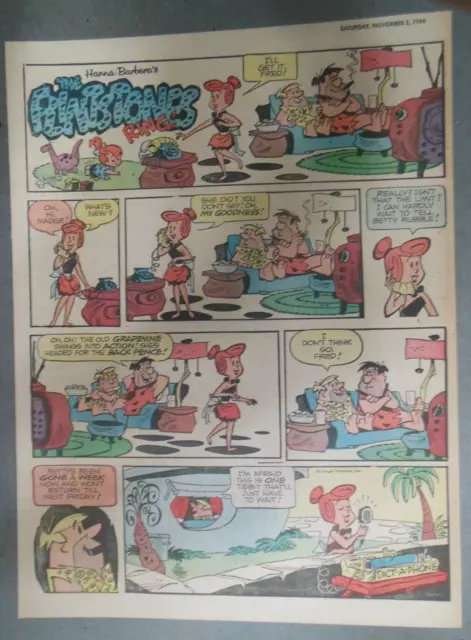
The Flintstones Sunday Page by Hanna-Barbera from 11/5/1966 Tabloid Size Page !
$4.00 Buy It Now 9d 3h
The Flintstones Sunday Page by Hanna-Barbera from 2/12/1966 Tabloid Size Page !
$4.00 Buy It Now 9d 3h
The Flintstones Sunday Page by Hanna-Barbera from 11/19/1966 Tabloid Size Page !
$4.00 Buy It Now 9d 3h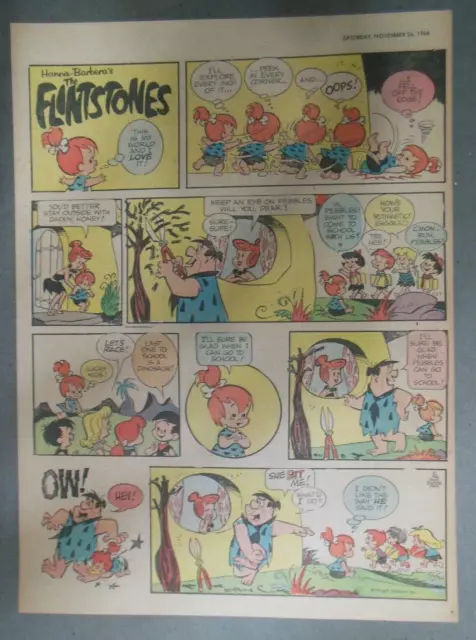
The Flintstones Sunday Page by Hanna-Barbera from 11/26/1966 Tabloid Size Page !
$4.00 Buy It Now 9d 3h
(48/52) The Flintstones Sunday Pages by Hanna-Barbera from 1969 Third Size Page
$150.00 Buy It Now 1 watcher
1 watcherThe Flintstones Sunday Page by Hanna-Barbera from 8/20/1966 Tabloid Size Page !
$4.00 Buy It Now 1 watcher
1 watcherThe Flintstones Sunday Page by Hanna-Barbera from 3/26/1966 Tabloid Size Page !
$4.00 Buy It Now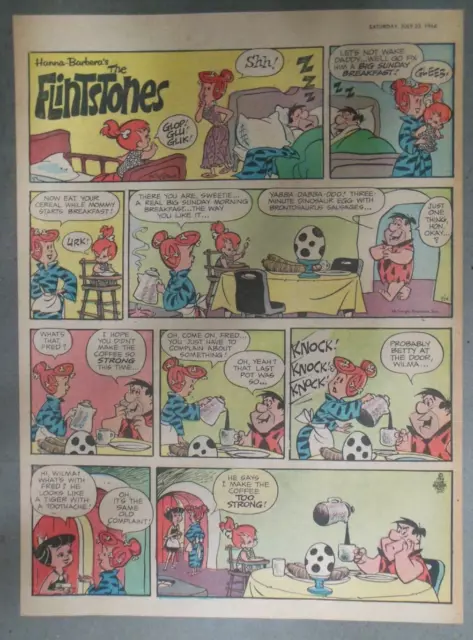 1 watcher
1 watcherThe Flintstones Sunday Page by Hanna-Barbera from 7/23/1966 Tabloid Size Page !
$4.00 Buy It Now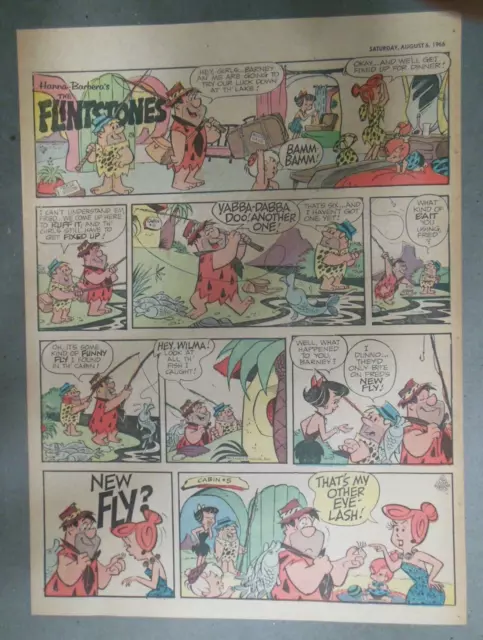 1 watcher
1 watcherThe Flintstones Sunday Page by Hanna-Barbera from 8/6/1966 Tabloid Size Page !
$4.00 Buy It Now
